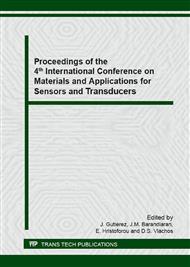p.129
p.133
p.137
p.145
p.153
p.157
p.163
p.167
p.171
Subnanometer Aluminium Oxide Film as a Model Photochemical Sensor
Abstract:
The growth and the atomic structure of alumina films of submonolayer to multilayer thickness evaporated onto the surface of Mo (110) crystal have been studied by Auger electron spectroscopy, high resolution electron energy loss spectroscopy and scanning tunneling microscopy. It is shown that the stoichiometry of the submonolayer film corresponds to that of the bulk oxide, and after achieving two monolayers the properties of the film largely resemble the properties of massive alumina. Deposition of the oxide at a substrate temperature of 1100 K results in the film structure corresponding to α-Al2O3. Such ultrathin oxide film is of considerable potential application in sensor physics and technology.
Info:
Periodical:
Pages:
153-156
Citation:
Online since:
May 2015
Keywords:
Price:
Сopyright:
© 2015 Trans Tech Publications Ltd. All Rights Reserved
Share:
Citation:


